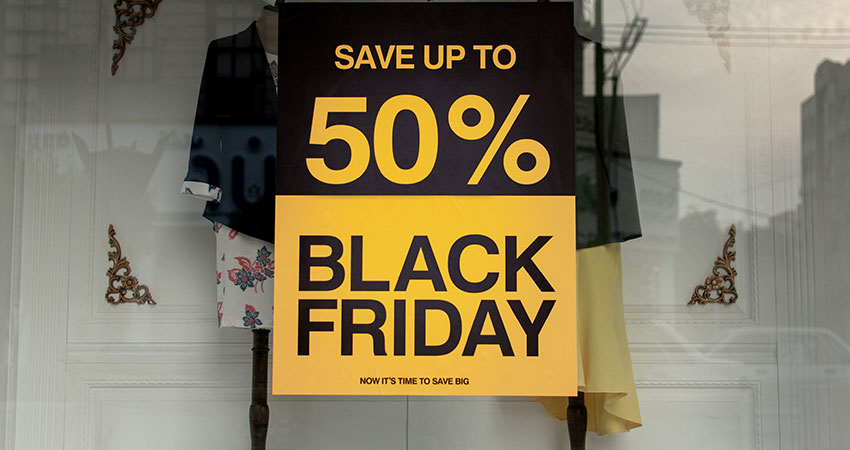Black Friday 2022 was a mixed bag between stores and online (Photo credit: Ashkan Forouzani on Unsplash)
In stores, Black Friday 2022 looked good in comparison to an average day this year or even a year ago, but less so when compared to pre-pandemic 2019. The story was flipped online, with low single-digit gains over 2021 but relatively flat from massive growth in the lockdown year of 2020.
According to Adobe Analytics, U.S. ecommerce sales on Black Friday hit a record $9.12 million, which was up just 2.3% from 2021, with electronics, smart home equipment, toys and exercise equipment the big winners vs. an average October day. Compared to 2019, online sales were up 23.2%.
MasterCard SpendingPulse had much more optimistic figures, pegging total U.S. retail sales growth on Black Friday at 12% over 2021, excluding automotive, with in-store sales up by the same figure and ecommerce gaining 14%. But look back farther, and the picture changes.
While mall foot traffic was up a healthy amount relative to earlier in the season, it was off compared to 2019, according to data from Placer.ai. Set against the first three weeks of November, visits were up about 277% at indoor malls and up 395% at outlet stores. But compared to 2019, indoor mall traffic fell 14.3% and outlet mall visits were down 17.8%. This held true across big box, home improvement and department stores.
“Even compared to a Black Friday in 2021 that was limited by rising COVID cases, and an active effort by retailers to shift focus away from the retail holiday, brick-and-mortar visits were down nearly across the board,” Placer.ai VP of Marketing Ethan Chernofsky told Seeking Alpha. “The data serves as the latest indication of the ongoing decline of Black Friday’s centrality.”
In terms of website activity, Bluecore found an 11% year-over-year increase in Black Friday site traffic, a 5% increase in orders and a 1% increase in average order values, despite earlier-than-ever promotions and inflationary pressure. Bluecore said Black Friday web traffic increased for every retail category except consumer electronics and footwear.
Here’s hoping retailers had invested in cyber security tools ahead of Black Friday — aka bot Friday — because the bad guys are knocking at the door. According to a spot check analysis of 1.6 million visits to its customers’ ecommerce websites from Friday to Sunday, Cheq found 24.4% of the organic and direct traffic was marked as invalid, coming from a combination of bots, scrapers and other malicious users.
The economy and inflation were clearly on the minds of consumers, and retailers responded. Discounting was a key driver on Black Friday, with Adobe reporting apparel peaking at an average 13.8% off list price, electronics discounting at 23.4%, and toys at 31.8%. Also, the sale of goods using increasingly popular buy now pay later plans (BNPL) were up an astounding 78% last week compared to the week prior, with BNPL revenue up a 81% in the same period.
“This Black Friday, retailers offered promotions across channels leading to strong year-over-year growth online and in-store,” said Steve Sadove, senior advisor for Mastercard and former CEO and Chairman of Saks Inc. “Apparel, electronics and restaurants were strong performing sectors as consumers turned holiday shopping into a full-day experience.”
Shoppers are also increasingly mobile. Orders made from smartphones represented nearly half of Black Friday sales, a record 48%, Adobe reported, up from 44% last year.
In terms of category winners, sales of toys online gained 285% vs. an average day in October, according to Adobe, while smart home items were up 271%, audio equipment was up 230%, electronics were up 221% and exercise equipment was up 218%.
“As Black Friday hit record spending online, we’re also seeing more prominent signs of a budget-conscious consumer this year,” said Vivek Pandya, lead analyst for Adobe Digital Insights. “Shoppers are embracing the Buy Now Pay Later payment method more this year to be able to buy desired gifts for family and friends.”
Morgan Stanley provided a scorecard of retailers on Black Friday. The bank’s analysts listed Lululemon Athletica, American Eagle Outfitters and Victoria’s Secret among the biggest winners. Channel checks showed Lululemon with long lines despite fewer discounts. And at Victoria’s Secret, sales were strong, offsetting weakness in its Pink brand.
American Eagle Outfitters (AEO) and Abercrombie & Fitch’s core brand were likewise cited for strong foot traffic and ecommerce sales. “In our view, this means these retailers’ assortments likely resonated with consumers and allowed these banners to drive relatively more profitable Black Friday revenue,” the Morgan Stanley analysts wrote. In a separate note, Bank of America cited strong traffic in apparel, electronics and grocery at Costco.
On the other side of the equation, A&F’s Hollister brand, and Gap Inc.’s flagship brand as well as Banana Republic were listed as “relative losers” for the holiday, with lower traffic despite deep discounting, according to Morgan Stanley.
Walmart and Five Below also saw higher-than-expected Black Friday traffic, while Ulta Beauty and Target were challenged in terms of visitors, the latter being “most surprising” based on the degree of discounting offered.
Looking past Black Friday, Morgan Stanley analysts worried consumers may hold off on further holiday spending until they see deep discounting again.
“Historically, when we have seen consumers hesitate to spend while retailers are overstocked with inventory, retailers have often reacted first, slashing prices on goods to clear out excess stocks,” analysts wrote. “In our view, this means discounting activity could worsen over the next five weeks. This would yield outsized margin pressure and keeps us cautious on the outlook for retailers’ profits this holiday season.”

